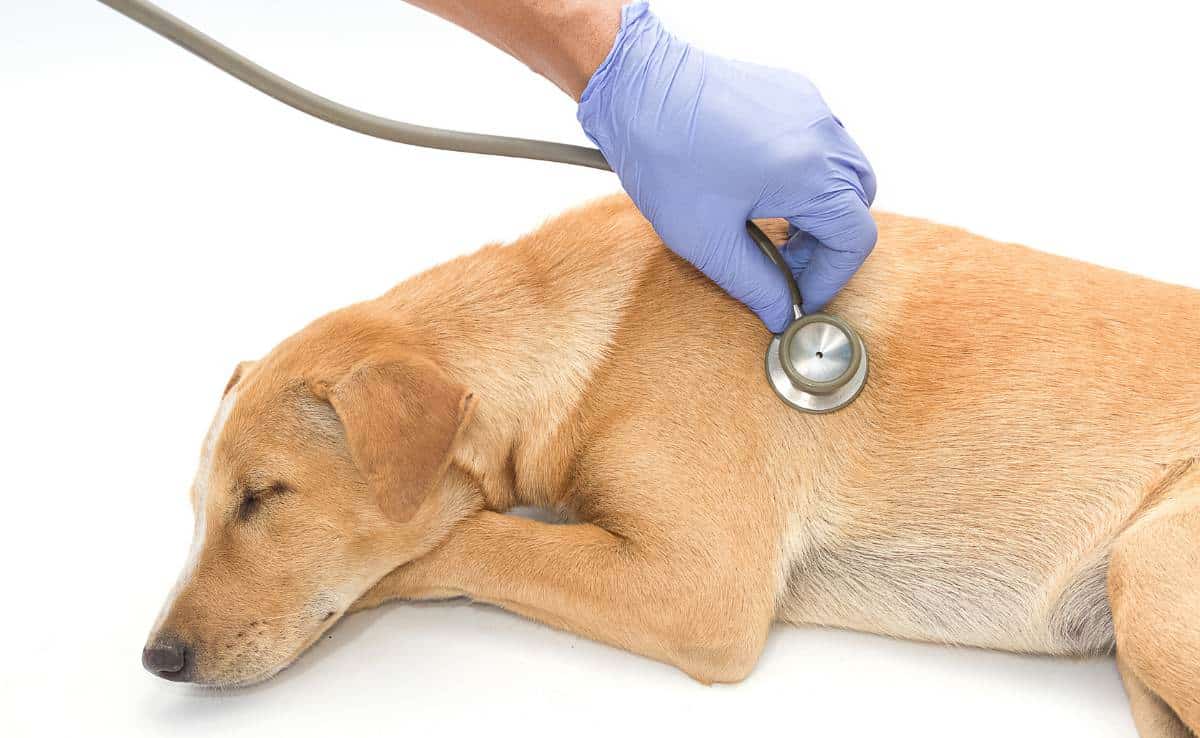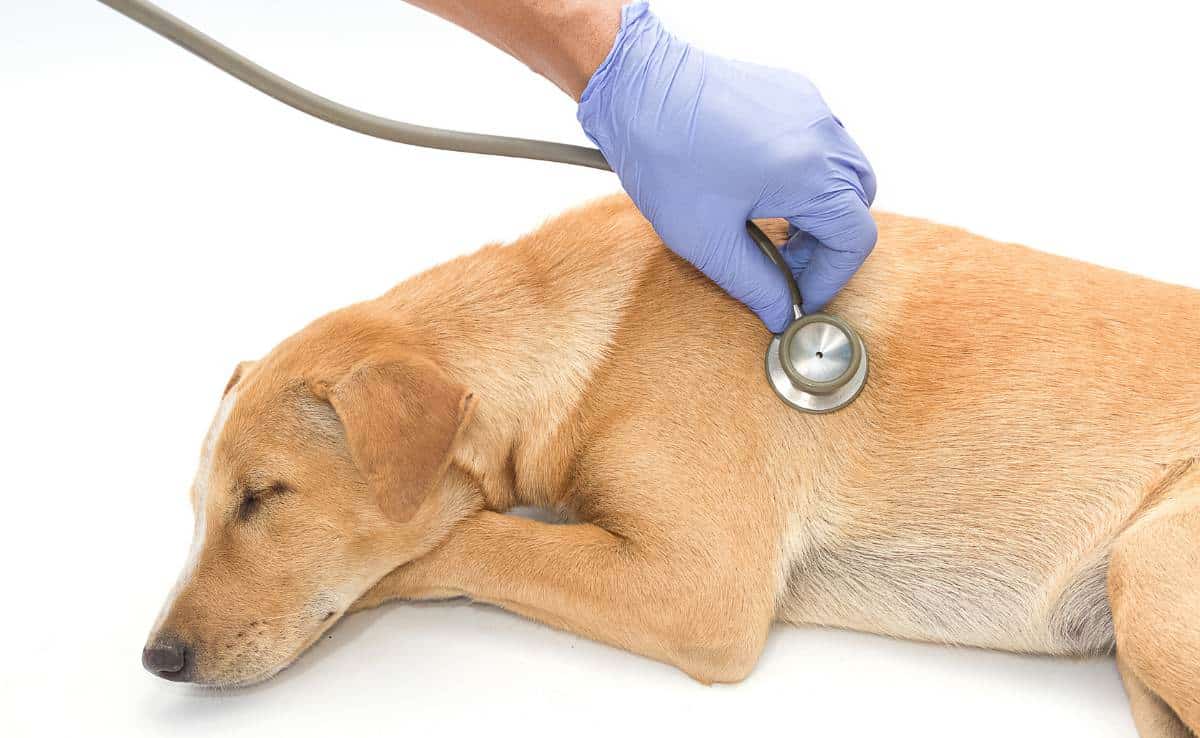
To keep the lights on, we receive affiliate commissions via some of our links. Our review process.

As our dogs get older and live longer, and with advances in veterinary care, more and more dogs are getting diagnosed with cancer. Learning that your beloved canine friend has cancer can be frightening. There are different types of lung cancer in dogs, and the prognosis varies. So, what are the signs of lung cancer in dogs? When should I worry about my dog coughing? And how is a lung tumor in dogs treated?
What Is Lung Cancer In Dogs?
Contents
Lung cancer is not common in dogs and only accounts for around 1% of all diagnosed cancers in dogs. Lung cancer refers to a chest tumor in dogs or a ‘pulmonary’ tumor. The prevalence of lung tumors in dogs appears to be increasing. This is mainly because dogs are living longer, and vets are developing more accurate diagnostic techniques.
Lung cancer falls into two main categories:
Primary Lung Tumors
Primary lung tumors are tumors that originate in the dog’s lungs. These tumors are normally malignant (cancerous), and the type refers to the type of cell they originate from. Bronchogenic adenocarcinoma is the most common type of primary tumor in dogs. They originate from the epithelial cells that line the bronchi. Squamous cell carcinomas and sarcomas can also originate in the lungs, but these are less common in dogs. Primary lung tumors can metastasize (spread) to other areas of the body, such as the lymph nodes or central nervous system (brain and spinal cord).
Metastatic Lung Tumors
Metastatic lung tumors are tumors originating from cancer elsewhere in the body, which has spread to the dog’s lungs. Cancers that start in any organ of the body can commonly spread to the lungs forming secondary tumors. Common cancers that spread to the lung include mammary (breast) cancer, liver cancer, bone cancer, and lymphoma.
Metastatic lung cancer in dogs is more common than primary lung cancer.
Symptoms Of Lung Cancer In Dogs
Not all dogs display symptoms of lung cancer, and around 25% of dogs show no symptoms at all.
Common symptoms of lung cancer include:
- Loss of appetite
- Weight loss
- Rapid, shallow breathing
- Exercise intolerance
- Lethargy
- Lameness if the tumor has spread to the bones
- Fever (high temperature)
- Coughing and coughing up blood
Coughing can be a sign of lung cancer in dogs. It is important to remember there are lots of causes of coughing in dogs that range from a chest infection to age-related changes such as bronchitis and heart disease. If your dog has a new, persistent cough, then it is advised to seek veterinary advice.
If your dog has a cough but is also struggling to breathe, his breathing is more labored, or he is coughing up blood, then this is an emergency, and you should seek urgent veterinary advice immediately.
Diagnosis Of Lung Cancer In Dogs
Lung cancer in dogs can be difficult to diagnose, and often multiple tests are needed. If your vet suspects your dog has lung cancer, they may perform a variety of tests, including:
- Chest Radiographs (x-rays) – X-rays are commonly performed under sedation or general anesthesia. Masses can be identified in the lungs on radiographs. However, it is not always clear if these masses are cancerous. Enlarged lymph nodes, localized infection, or lung abscesses can have a similar appearance to lung tumors and therefore, additional tests are often required.
- Blood Tests And Urinalysis – Assesses organ function and the general health of your dog.
- Abdominal Ultrasound – This may be used to assess whether cancer has spread to other organs outside the lungs.
- CT Scan – A CT scan uses x-rays to create a 3D image. A CT scan may give a more detailed image of your dog’s lungs and tell if the mass can be surgically removed.
- Ultrasound-Guided Aspiration Or Biopsy – Depending on the location of the tumor, a sample of the cells within the mass can be taken for testing by guiding a needle into the mass. This can be performed from the outside of the chest using ultrasound to guide the needle or inside the chest using a camera that is inserted down the airways (bronchoscopy).
Dog Lung Cancer Treatment
Surgery is the preferred option for primary lung tumors in dogs, mainly bronchogenic adenocarcinoma. If the lung tumor is a solitary mass, then removal of one lung lobe may be possible. If the tumor has spread to the lymph nodes or other structures in the chest, then surgery is often not possible.
Radiation treatment or chemotherapy may be suitable for some tumors that are not able to be removed surgically or in addition to surgery to reduce the risk of recurrence.
Dog Lung Cancer Prognosis
Many factors affect the prognosis for dogs with lung tumors. The type of tumor, size, whether it has spread to lymph nodes or other organs, and whether it can be surgically removed all influence how likely it is a dog with lung cancer can be treated. Dogs with a single primary lung tumor that has not spread to the lymph nodes have the best prognosis and many survive more than 12 months. Unfortunately, if there are multiple tumors or the lymph nodes are involved, then survival time is much shorter (around 1-4 months).
End-stage lung cancer in dogs that has spread to organs outside of the chest carries a very poor prognosis. Treatment is likely to be palliative at this stage, and your vet may advise euthanasia if your dog has severe symptoms that limit his or her quality of life.
Frequently Asked Questions
How do dogs get lung cancer?
Cancer is caused by the mutation of genes within a cell that results in the uncontrolled growth of those cells. It is a random event. Some environmental factors can increase the risk of cell mutation, including radiation, pollution, and cigarette smoke. The main risk for dogs developing lung cancer is age. This disease is most often found in canines that are ten years or older.
What breeds of dogs get lung cancer?
Any breed of dog can be affected by lung cancer. The average age of dogs with primary lung tumors is around 10 years old. Breeds that are at increased risk of developing primary lung tumors include the Boxer, Doberman pinscher, Irish Setter, German Shepherd, and Bernese Mountain dogs.
Misdiagnoses of lung cancer in dogs
A definitive diagnosis of cancer is normally made on a tissue biopsy, where the cells are analyzed at a laboratory. The lungs are a difficult place to biopsy, and therefore veterinarians often have to rely on other diagnostic tests such as chest x-rays or a CT scan to diagnose lung tumors. In rare cases, other diseases of the lungs, such as infections or abscesses, can appear similar to lung tumors leading to misdiagnosis. Your veterinarian may suggest repeated imaging after treatment to assess the response to treatment and confirm a diagnosis.
Can lung cancer in dogs be diagnosed using an x-ray?
Yes, some chest tumors are visible on radiographs (x-rays). In other cases, further diagnostic tests are needed to make a diagnosis of lung cancer in dogs, including CT scans, bronchoscopy (camera study), and tissue biopsy.
Can dogs recover from lung cancer?
Primary lung tumors are nearly always malignant (cancerous), and recurrence is unfortunately common. If the lung tumor can be completely removed surgically, then dogs have a better prognosis and can live a normal life following surgery.
Is lung cancer in dogs painful?
Most types of cancer cause some pain in dogs, and we are learning more about how to manage pain associated with cancer in dogs. Lung tumors that spread to the bones or other organs can be associated with considerable pain. If your dog has been diagnosed with a lung tumor, your veterinarian may prescribe pain relief to help keep your dog comfortable.
Other Types Of Canine Cancer
Lung cancer in dogs is a serious diagnosis and unfortunately, not all tumors can be treated. Surgical treatment can be invasive. Recovery time is often relatively short in dogs. It is not possible to diagnose a lung tumor without diagnostic tests such as chest x-rays. If you are concerned that your dog has symptoms of lung cancer, then don’t delay in seeking veterinary advice. Earlier detection may mean more treatment options are available for your pooch. Learn about other signs of cancer in dogs and find out if pet insurance covers cancer or not.
Tagged With: Cancer